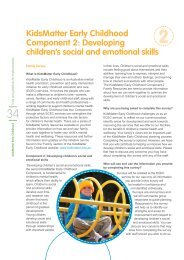[1008KB]pdf - KidsMatter
[1008KB]pdf - KidsMatter
[1008KB]pdf - KidsMatter
You also want an ePaper? Increase the reach of your titles
YUMPU automatically turns print PDFs into web optimized ePapers that Google loves.
Contents<br />
Social development 1<br />
Influences on children’s social development 2<br />
Developmental trends in children’s self-concept 2<br />
Culture and self-concept 3<br />
Learning social values 3<br />
General principles for supporting children’s social development 4<br />
Children’s social development<br />
Children grow and change in many ways during their primary school years. As well as growing<br />
physically, children develop socially, emotionally and cognitively. <strong>KidsMatter</strong> Primary has<br />
produced this booklet for parents, carers and school staff on children’s development. This booklet<br />
discusses three dimensions of children’s development – social, emotional and cognitive (thinking<br />
and learning) development. To get a more complete overview of children’s development we<br />
recommend referring to the entire booklet. The focus of this section is children’s social development.<br />
Children’s social development<br />
Social development<br />
This involves learning the values, knowledge and skills<br />
that enable children to relate to others effectively and<br />
to contribute in positive ways to family, school<br />
and the community. This kind of learning<br />
is passed on to children directly by<br />
those who care for and teach them,<br />
as well as indirectly through social<br />
relationships within the family or<br />
with friends, and through children’s<br />
participation in the culture around<br />
them. Through their relationships<br />
with others and their growing<br />
awareness of social values and<br />
expectations, children build a<br />
sense of who they are and of the<br />
social roles available to them. As<br />
they develop socially children both<br />
respond to the influences around<br />
them and play an active part in<br />
shaping their relationships.<br />
1
Children’s social development<br />
Influences on<br />
children’s social<br />
development<br />
While parents and carers are clearly<br />
the first and most important<br />
influences on children’s social<br />
development, there are many other<br />
influential aspects of the social<br />
environment. Examples of the many<br />
influences on children’s development<br />
are shown in the following diagram.<br />
The people and settings that<br />
are most closely involved<br />
with the child – family, school<br />
and peers – are shown at<br />
the centre of the diagram.<br />
Through their daily contact<br />
with parents, carers, family<br />
members, teachers and other<br />
school staff as well as with their<br />
peers, children learn about<br />
the social world and about<br />
the rules, practices and values<br />
that support it. By actively<br />
participating in these<br />
relationships, children<br />
also affect the ways that<br />
adults and their peers<br />
relate to them.<br />
In addition, children’s<br />
development is influenced<br />
by wider networks of social<br />
support (represented in the<br />
diagram’s central circles),<br />
including extended family,<br />
friends and any community,<br />
cultural or religious groups a<br />
child may be part of. These<br />
networks provide opportunities<br />
for children to develop their<br />
social awareness and skills as they<br />
relate with different people and<br />
experience a range of roles and<br />
expectations.<br />
As shown in the outer circle in<br />
the diagram, children’s lives are<br />
also shaped by the broader social<br />
circumstances that impact on their<br />
families and communities, such as<br />
access to social and health services,<br />
parents’ employment and income,<br />
or their ability to balance work and<br />
Economic<br />
issues<br />
Cultural<br />
values<br />
Parents<br />
employment<br />
Religious<br />
community<br />
Home-school<br />
connection<br />
Family<br />
Extended<br />
family<br />
Community<br />
connections<br />
School<br />
Social and<br />
health services<br />
Environment<br />
family time. In particular, children’s<br />
sense of social connection is often<br />
influenced by community attitudes<br />
and by cultural values, including<br />
those they encounter in the media.<br />
Through their relationships and<br />
connections with others, children<br />
build a sense of who they are and<br />
where they fit in the social world.<br />
Coming to an understanding about<br />
self and others is therefore a central<br />
goal of children’s social development.<br />
Peers<br />
Family<br />
friends<br />
Sporting and<br />
social groups<br />
Media<br />
Housing<br />
Government<br />
policies<br />
Developmental trends in children’s self-concept<br />
The ideas, beliefs and knowledge that children have about<br />
who they are, what they can do and where they fit in<br />
society help to shape their understanding of themselves.<br />
Children base their self-concepts on feedback they receive<br />
from others as well as their own judgments. The kinds of<br />
things that primary school children take into account in<br />
developing their self-concepts include how well they are<br />
able to succeed with schoolwork and other activities, how<br />
they look, and how they get on with family and peers.<br />
Developmental patterns in the ways children typically<br />
describe themselves are related to their developing<br />
capacities for thinking and for understanding and<br />
managing their emotions and behaviour. As shown in the<br />
following table, preschool children often have very high<br />
opinions of their abilities. During primary school children<br />
become much more aware of how their abilities and<br />
achievements compare with those of others.<br />
2
Typical developmental changes in children’s self-concepts<br />
Developmental stage What children might say about themselves What it shows<br />
Preschool<br />
“I am four years old. I live with my Mum and<br />
Dad and my little sister. I love to play football. I<br />
can kick the ball really far. Watch me!”<br />
• Describes physical appearance, family<br />
context and favourite activity.<br />
• Has high opinion of own abilities and<br />
wants to show you.<br />
Primary school<br />
Secondary school<br />
Culture and self-concept<br />
“I am pretty good at maths because I get<br />
good marks. But I’m not so good at English,<br />
not like Sophie. Kids like to play with me<br />
because I’m happy most of the time and I’m<br />
kind.”<br />
“I’m pretty talkative and funny with my<br />
friends. I’m an extravert. At home I can be<br />
pretty moody. I get annoyed with my parents<br />
because they always seem to be on my back.<br />
But, I guess, where would I be without them?”<br />
Having a strong cultural identity enhances children’s<br />
self-concept and promotes a sense of connectedness<br />
and belonging. Children’s cultural identity is nurtured<br />
when they learn about their own cultural traditions and<br />
when those around them show respect for their cultural<br />
values. Teaching children to respect and appreciate<br />
variations and differences between cultures is therefore<br />
very important for all children’s social development.<br />
Cultural identity development is sometimes complex<br />
for children from minority cultural groups. They<br />
often encounter differences between the rules and<br />
expectations required at school and those they<br />
are used to at home. When the differences are not<br />
acknowledged, or when the cultural traditions children<br />
identify with are ignored or minimised, it can negatively<br />
affect children’s sense of connectedness and belonging.<br />
Children from minority cultures may be subjected to<br />
stereotyping and discrimination on the basis of their<br />
ethnicity, religion, gender, appearance, social class or<br />
sexuality. Discrimination and bullying can have serious<br />
effects on chidren’s mental health as well as their social<br />
development. By contrast, overcoming discrimination<br />
has been found to have positive effects on self-concept.<br />
It is very important for parents, carers and teaching staff<br />
to encourage and support children to take positive<br />
action against discrimination and bullying by speaking<br />
up and reporting incidents.<br />
• Compares self with others.<br />
• Determines own ability level by ranking<br />
performance against that of peers.<br />
• Able to make a (more) realistic<br />
assessment of own abilities.<br />
• Able to reflect on and evaluate own<br />
qualities.<br />
• Understands and accepts that personal<br />
characteristics can be changeable and<br />
inconsistent.<br />
• Is able to integrate them into a coherent<br />
sense of self.<br />
It is very important for children’s strengths and efforts to be recognised in order to support the development of a positive<br />
self-concept and to motivate children to be positively engaged in learning and in their relationships. Poor self-concept<br />
can be a significant contributing factor to children’s emotional and behavioural difficulties.<br />
Learning social values<br />
Children’s ability to understand others and take their<br />
needs and views into account develops over time.<br />
Young children are naturally self-focussed. They often<br />
play beside, rather than with, other children and tend<br />
to think that everyone sees things the same way that<br />
they do. In early primary school children learn that<br />
others may see things differently from them. Then,<br />
as their thinking skills develop, children are more able<br />
to understand another person’s point of view and,<br />
finally, to appreciate multiple ways of looking at the<br />
same event or situation.<br />
Teaching children how to put themselves in<br />
someone else’s shoes helps them to relate better<br />
to others and manage conflict more effectively.<br />
It promotes caring, respect and fairness. Research<br />
shows that children who<br />
have learned to value<br />
others are more<br />
likely to include<br />
and appreciate<br />
children who<br />
are different<br />
from them<br />
or who are<br />
viewed<br />
negatively by<br />
others.<br />
Children’s social development<br />
3
Research into moral development has highlighted how social behaviour reflects the attitudes<br />
people hold about social conventions and about themselves. Learning to take account of others’ feelings, perspectives and<br />
expectations contributes to children’s understanding of social values, and to the values and ethics they choose for themselves.<br />
The following table uses examples from the accompanying story, titled ‘I dare you’, to illustrate how the characters used different<br />
kinds of moral reasoning to decide what to do and say about breaking the window of the neighbour’s car.<br />
Children’s social development<br />
Example<br />
Ella says: “I dare you”.<br />
Tao says: “Let’s go before anyone sees us”.<br />
Ella says: “We don’t know anything about it”.<br />
Harry says: “We’re in trouble now”.<br />
Tao says: “They told me to do it”.<br />
Harry says: “It wasn’t his fault. It was that<br />
stupid game”.<br />
Further ideas for<br />
supporting children’s<br />
social development<br />
are provided in the<br />
accompanying materials:<br />
• “I dare you!”<br />
• Supporting children’s<br />
social development<br />
– Suggestions for<br />
parents and carers<br />
• Supporting children’s<br />
social development<br />
– Suggestions for<br />
teaching staff<br />
Kind of moral thinking<br />
• Thinking is focussed on impact on self.<br />
• Decisions about right and wrong are based on avoiding<br />
punishment or on personal gain.<br />
• Emphasises responsibility and what others think.<br />
• Decisions are based on gaining approval from others and/or on<br />
meeting laws and social obligations.<br />
• Emphasises understanding the particular circumstances and<br />
coming to a fair outcome.<br />
• Decisions are based on principles of justice and compassion.<br />
Children learn to make ethical judgments through having practice in putting themselves in others’ shoes and through<br />
being encouraged to reflect on issues that involve social and moral values. Families and schools need to work together to<br />
help children understand and learn to act on values like respect, responsibility, caring for others, honesty, cooperation and<br />
acceptance of people’s differences.<br />
General principles for supporting<br />
children’s social development<br />
Children’s earliest and most extensive learning about social relationships occurs<br />
in the family. Parents and carers can support positive social development when<br />
they treat children with respect and consideration and encourage children to be<br />
similarly respectful in all their relationships.<br />
• Provide care and support by tuning into children’s needs. Show you are willing<br />
to listen and take children’s feelings into consideration.<br />
• Help children to develop social skills by providing coaching and teaching them<br />
to think through and solve the day-to-day social difficulties they encounter.<br />
Supervise and support children’s social activities without taking over.<br />
• Ask questions that encourage children to put themselves in someone else’s<br />
shoes. Questions like “How would you feel if …?” help children learn skills for<br />
perspective taking. Asking questions in a supportive way helps children to<br />
think through situations and encourages them to take others’ feelings and<br />
perspectives into account.<br />
• Discuss moral issues with children and encourage them to state their opinions<br />
and reasons.<br />
Further information on supporting children’s development and <strong>KidsMatter</strong> Primary can be found on our website:<br />
www.kidsmatter.edu.au/resources/information-resources/<br />
This resource is part of the <strong>KidsMatter</strong> Primary initiative. We welcome your feedback at www.kidsmatter.edu.au<br />
© Commonwealth of Australia 2011. Australian schools are permitted to copy material freely for communication with teachers, students, parents/carers and community members.<br />
While every care has been taken in preparing this material, the Commonwealth does not accept liability for any injury or loss or damage arising from the use of, or reliance upon, the content of this publication.<br />
4


![[1008KB]pdf - KidsMatter](https://img.yumpu.com/38050895/1/500x640/1008kbpdf-kidsmatter.jpg)
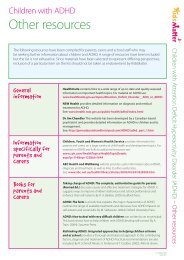
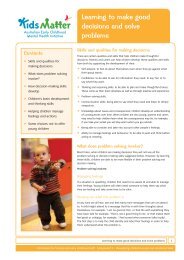
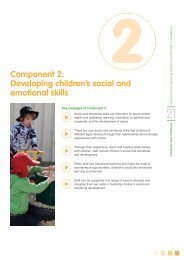
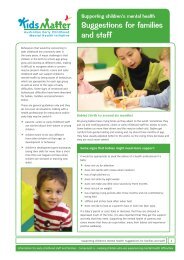
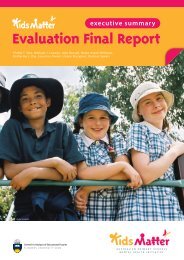

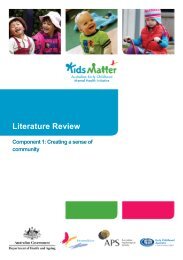
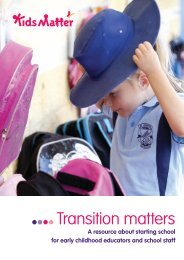
![Trinity Anglican School - Cairns story [378KB]pdf - KidsMatter](https://img.yumpu.com/41716076/1/184x260/trinity-anglican-school-cairns-story-378kbpdf-kidsmatter.jpg?quality=85)
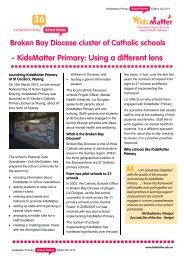
![Happy families work together [327KB] PDF - KidsMatter](https://img.yumpu.com/40767384/1/184x260/happy-families-work-together-327kb-pdf-kidsmatter.jpg?quality=85)
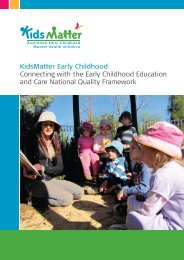
![Action Team Handbook 2012 [1.9M] [PDF] - KidsMatter](https://img.yumpu.com/38050920/1/184x260/action-team-handbook-2012-19m-pdf-kidsmatter.jpg?quality=85)
